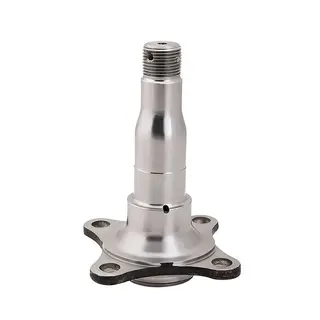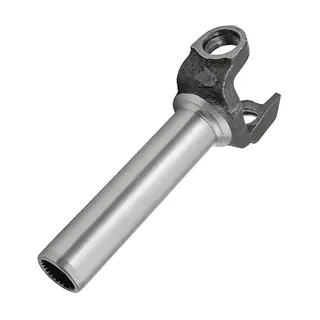In the complex systems of modern industry, although a flange is a small component, it plays a crucial role. It acts like a joint in the pipeline system, tightly connecting pipes, various valves, and equipment inlets and outlets, ensuring smooth fluid flow within the pipeline while maintaining the stable operation of the entire system. Forging technology is the key magic that gives flanges excellent performance. Today, let us delve into the fascinating world of flange forging.
Forging is a processing method that uses external force to induce plastic deformation in metal materials to obtain blanks or parts with the required shape, size, and certain mechanical properties. Imagine a blacksmith by the furnace, placing a glowing iron block on the anvil and repeatedly hammering it with a large hammer, the iron gradually takes the desired shape. This process is the prototype of forging. In modern industry, forging technology has become highly mechanized and automated, but its core principle remains unchanged.
Forging technology is mainly divided into three types: open-die forging, die forging, and impression-die forging.
Open-die forging is like freely shaping a piece of soft clay. The operator gradually forges the billet into the required shape through some basic deformation processes such as upsetting, stretching, and punching. This method is highly flexible and suitable for producing simple-shaped parts in small batches, such as large flange blanks.
Die forging is like casting in a mold, but performed on solid metal. The heated billet is placed into a die fixed on forging equipment and, under powerful pressure, fills the mold cavity to form a part with precise shape and high dimensional accuracy. Flanges produced by die forging have more reasonable fiber structure distribution, effectively improving part service life and are the main process for producing high-quality flanges.
Impression-die forging lies between open-die forging and die forging. It uses simple molds to partially shape the billet and is suitable for medium-batch production of more complex-shaped parts.
Before diving deeper into flange forging, let's understand the main steps. Flange forging is a complex and precise process, and every step is crucial, jointly determining the final quality and performance of the flange.
Material cutting is the first and crucial step in forging. It is like a tailor measuring and cutting cloth: based on the flange design dimensions and shape, suitable billets are cut from the raw material. Cutting accuracy directly affects subsequent forging efficiency and quality. Excessive material increases waste, energy consumption, and die wear; insufficient material may lead to undersized parts or scrap. Mechanical cutting and flame cutting are commonly used, with flame cutting often employed for large flange billets as it can quickly and accurately cut the desired shape from thick steel plates or billets.
Heating is an indispensable step in forging. After heating, the metal's atomic mobility increases, plasticity improves, and deformation resistance decreases, making forging easier. However, heating is a double-edged sword, potentially causing issues like oxidation, decarburization, overheating, and burning. Oxidation and decarburization degrade surface quality and affect subsequent processing and performance, while overheating or burning can deteriorate the internal structure, causing cracks and defects. Therefore, precise control of heating temperature and time is crucial. Common heating methods include flame furnace heating and induction heating. Flame furnace heating is low-cost and versatile but slower and prone to oxidation and decarburization; induction heating is rapid and causes less oxidation but is less adaptable to shape, size, and material variations and has higher equipment costs.
Forming is the core stage of forging, shaping the heated billet into the required shape and size using various forging equipment and processes. Different forging technologies have different forming methods.
In open-die forging, operators use air hammers, steam hammers, or hydraulic presses to gradually shape the billet through basic deformation processes such as upsetting, stretching, stamping, bending, and cutting. For example, upsetting forges the billet along the axis, reducing height and increasing diameter, commonly used for gear blanks and other disc parts; stretching increases length while reducing cross-section, used for shaft part blanks.
In die forging, forming occurs inside the die under high pressure, filling the mold cavity to create precise flanges. Basic steps include blanking, heating, pre-forging, final forging, flash trimming, and edge cutting. Pre-forging shapes the billet initially to reduce deformation in final forging, while final forging ensures precise dimensions and shape.
The cooling process after forging also significantly affects the flange's final performance. Different cooling rates result in different internal structures and properties. Generally, slow cooling allows internal stresses to be fully released but may coarsen grains, reducing strength and toughness. Rapid cooling refines grains, improving strength and hardness but may increase residual stress. Therefore, selecting the appropriate cooling method according to flange material and requirements is crucial. For high-strength alloy steel flanges, quenching followed by tempering may be used: rapid quenching forms high-strength martensite, followed by tempering to relieve stress and adjust hardness, achieving optimal performance.
Compared with ordinary cast flanges, forged flanges have many advantages:
The raw materials, usually pipe billets, undergo cutting and forging to effectively eliminate segregation, porosity, and other defects present in ingots. These defects are difficult to avoid in casting, and repeated hammering during forging densifies the internal structure, producing more uniform performance.
Forged flanges have superior mechanical properties. Optimized metal fiber structure increases strength and toughness, allowing forged flanges to withstand higher pressure and complex working conditions, resulting in longer service life.
Forged flanges have higher dimensional accuracy and better surface quality. Flanges produced by die forging can achieve high dimensional precision, requiring minimal post-processing, improving efficiency and reducing production costs.
Due to these advantages, forged flanges are widely used in important industrial fields:
Oil and chemical industries: Pipelines subjected to high pressure, high temperature, and corrosive media rely on forged flanges for reliable and safe connections. For instance, during petroleum refining, high-temperature, high-pressure oil and gas transmission requires forged flanges' high strength and sealing performance to prevent leakage and ensure safe operation.
Mechanical manufacturing: Forged flanges are used as connection components in machinery, such as spindles of large machine tools and gearbox flanges. These parts bear heavy mechanical loads, and forged flanges' strength and toughness meet these demands.
Aerospace: Parts such as aircraft engine intake flanges or wing-to-fuselage connections require high-quality forged flanges to ensure safe flight.
Forged flanges are mainly made of carbon steel, alloy steel, and stainless steel:
Carbon steel: Most common, good mechanical properties and machinability, relatively low cost, suitable for general industrial pipelines.
Alloy steel: Carbon steel with added elements such as chromium, nickel, and molybdenum for increased strength, toughness, and corrosion resistance. Chromium-containing alloy steel has better oxidation and corrosion resistance, suitable for high-temperature, high-pressure, and corrosive conditions.
Stainless steel: Excellent corrosion resistance, able to work stably in acidic, alkaline, or saline environments, often used in chemical, food, and pharmaceutical pipelines.
Production follows strict standards to ensure quality and performance, including GB (China), JB (China), ANSI (USA), DIN (Germany), and JIS (Japan). Different countries' standards vary in flange dimensions, tolerances, pressure ratings, and material requirements. Users should select the appropriate standard according to project and operating conditions. For typical domestic projects, GB flanges often suffice, while large multinational or high-quality projects may prioritize ANSI or DIN flanges.
Quality control is a systematic process throughout production:
Raw material procurement: Strictly control chemical composition and mechanical properties, as material quality is the foundation of forged flange quality.
Forging process: Follow process specifications, controlling heating temperature, deformation amount, and cooling speed.
Process inspection: Inspect forged parts after each step, detecting defects such as cracks or pores via ultrasonic testing, and checking hardness.
Final inspection: Comprehensive evaluation of dimensional accuracy, surface quality, and mechanical properties. Only fully qualified products are shipped.
Heat treatment is a key post-forging process, decisively affecting performance. It controls heating and cooling to change internal structure and achieve required mechanical and physical properties. Common methods include annealing, normalizing, quenching and tempering, and aging:
Annealing: Heat, hold, and slow-cool to reduce hardness, improve plasticity, toughness, and machinability.
Normalizing: Heat above critical temperature, hold, and air-cool to refine grains, homogenize structure, and improve mechanical properties.
Quenching and tempering: Achieve high strength while relieving stress.
Aging treatment: For special alloys, enhances strength and hardness through solution supersaturation and controlled aging.
In summary, flange forging is not only a precise industrial process but also an art that balances strength, precision, and durability. Through scientific material selection, strict process control, and comprehensive heat treatment, forged flanges can operate stably and reliably under high pressure, high temperature, and complex conditions, becoming indispensable connection components in petroleum, chemical, mechanical, and aerospace industries. Their superior performance and long service life are key supports for the safe and efficient operation of modern industrial pipeline systems.



